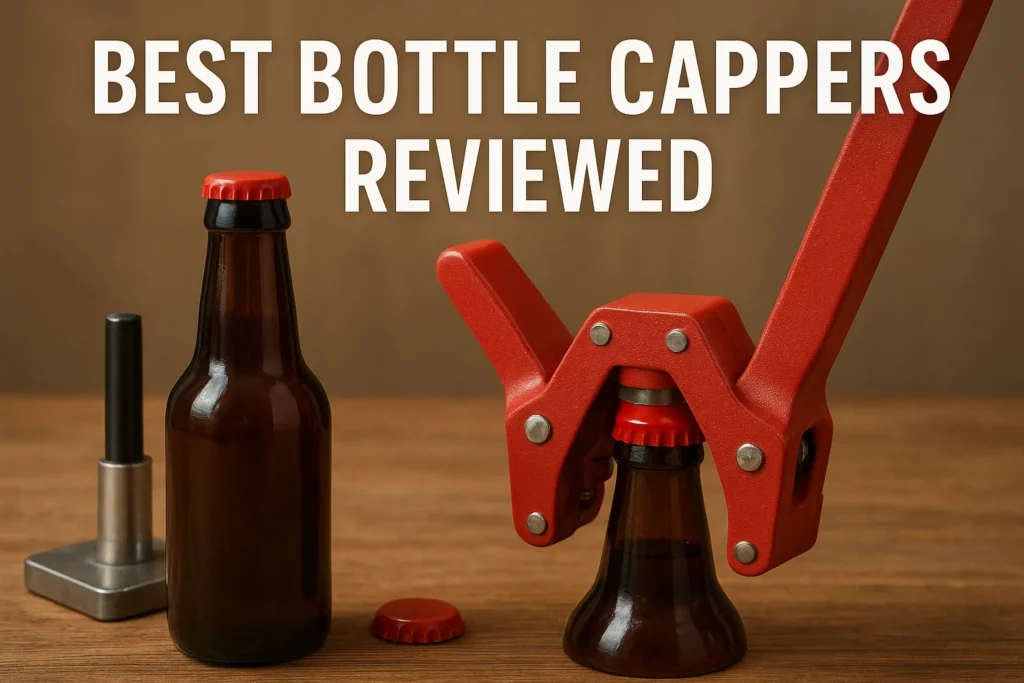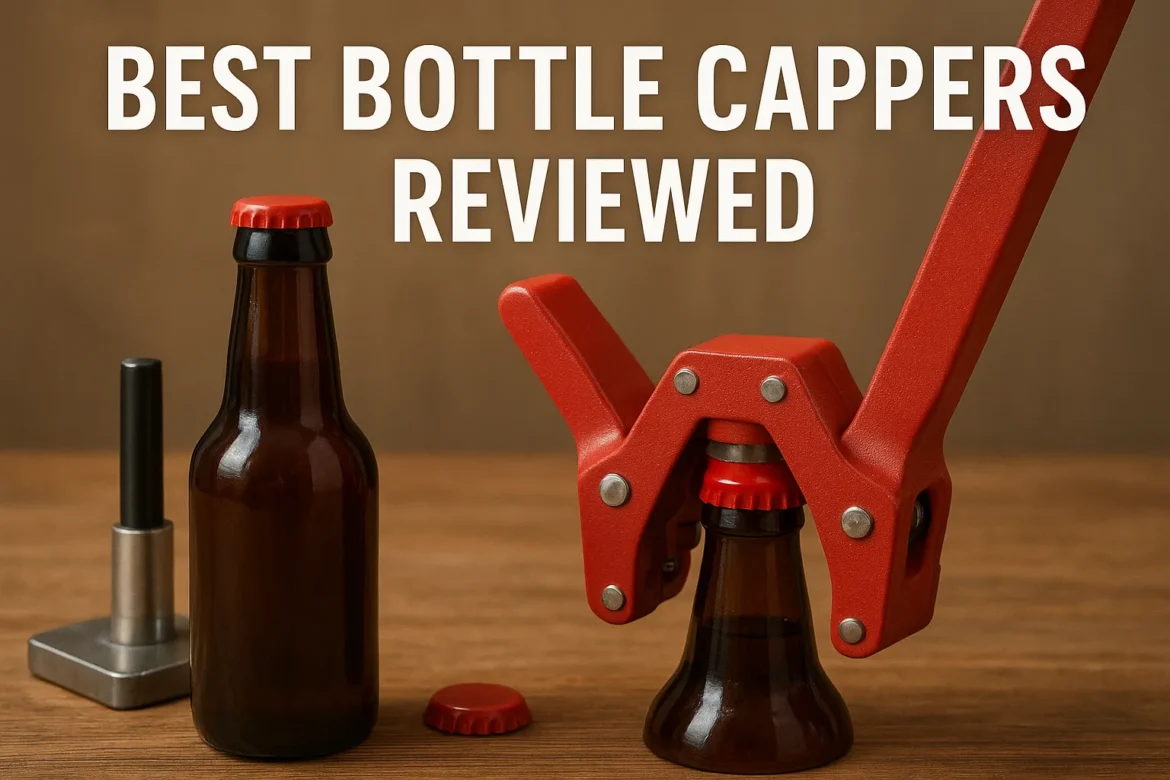Find the Best bottle cappers reviewed for homebrewing with our comprehensive review guide. Compare handheld, bench, and automatic cappers with detailed performance analysis, pros and cons, and expert recommendations to choose the perfect bottle capping solution for your brewing needs.

Selecting the right bottle capper can transform bottling day from a tedious chore into an efficient, satisfying process that puts the perfect finishing touch on your brewing efforts. After fifteen years of brewing and testing virtually every bottle capper design available—from basic wing cappers to sophisticated pneumatic systems—I can confidently state that capper choice significantly impacts not just bottling efficiency, but cap quality, consistency, and overall brewing satisfaction.
My bottling evolution began with a basic plastic wing capper that served adequately for small batches but quickly revealed its limitations during larger bottling sessions. The breakthrough came with my first quality bench capper, which revolutionized not just bottling speed but cap consistency and reduced the physical strain that made bottling sessions something to endure rather than enjoy.
This comprehensive review examines the top bottle cappers across all categories, analyzing performance through systematic testing, real-world brewing scenarios, and detailed evaluation of build quality, ease of use, and long-term reliability. From budget-friendly handheld models to professional-grade bench systems, understanding capper capabilities ensures your investment delivers consistent results while supporting your brewing ambitions.
Whether you’re bottling occasional homebrew batches or scaling toward commercial production, choosing the right capper affects every bottle you produce, influencing cap quality, operational efficiency, and the professional appearance that reflects your brewing excellence.
Understanding Bottle Capper Technology and Design Principles
Modern bottle cappers utilize various mechanical approaches to achieve consistent crown cap crimping while accommodating different bottle sizes and operational requirements. Understanding these fundamental design principles guides intelligent capper selection and optimal usage techniques.
Crimping Mechanisms and Force Distribution
Quality cappers distribute crimping force evenly around crown cap circumferences through precisely engineered bell and jaw systems. The crimping action must compress the cap liner against bottle lips while maintaining consistent pressure that prevents over-crimping or inadequate sealing.
Leverage Systems and Mechanical Advantage
Handheld cappers use lever systems to multiply applied force, with longer handles providing greater mechanical advantage that reduces required operator effort. Bench cappers utilize compound leverage and mechanical advantage to achieve professional crimping with minimal physical exertion.
Adjustability and Bottle Compatibility
Professional cappers accommodate various bottle heights and neck configurations through adjustable mechanisms that ensure proper cap positioning and crimping regardless of bottle variations. This adaptability prevents capping failures while maintaining consistent seal quality.
Material Quality and Durability Considerations
Construction materials directly affect capper longevity and performance consistency. Metal components provide superior durability and precision compared to plastic alternatives, though quality plastics can deliver adequate performance for moderate usage levels.
Magnetic Systems and Cap Handling
Integrated magnets hold caps in proper position during capping operations, preventing misalignment that causes sealing failures. Quality magnetic systems maintain secure cap retention while enabling easy removal after crimping completion.
Best Bottle Cappers Reviewed Handheld Wing Capper Analysis
Wing-style cappers represent the most common entry point for homebrewers, offering adequate performance at budget-friendly prices while remaining compact and portable for occasional use.
Red Baron Classic Wing Capper
The Red Baron remains the most recognizable wing capper design, providing reliable performance through time-tested mechanisms and widespread availability. The plastic construction keeps costs minimal while the dense material provides adequate weight for stable capping operations.
Performance testing reveals consistent crimping when proper technique is employed, though the dual-wing operation requires coordinated pressure application that can challenge new users. The compact design enables easy storage while the low cost makes it accessible for beginning brewers.
Brooklyn Brew Shop Metal Wing Capper
This upgraded wing capper features metal construction with extended handles that provide enhanced leverage and control during capping operations. The longer wings reduce required effort while the metal construction offers improved durability compared to plastic alternatives.
The tin construction provides additional weight that aids capping stability, though it increases operator fatigue during extended bottling sessions. The included caps add immediate value while ensuring compatibility with the capper mechanism.
Universal Rigamonti Wing Capper
Available in different sizes for 26mm and 28mm caps, the Rigamonti capper offers enhanced durability through metal construction while maintaining the familiar wing-style operation. The longer arms provide improved leverage while the robust construction supports frequent use.
Testing demonstrates reliable performance with consistent crimping quality, though the mechanism leaves small depressions in cap centers that affect aesthetic appearance without compromising sealing integrity.
| Wing Capper Model | Construction | Handle Length | Weight | Cap Sizes | Price Range |
|---|---|---|---|---|---|
| Red Baron Classic | Dense Plastic | Standard | Light | 26mm | $10-15 |
| Brooklyn Brew Shop | Tin Metal | Extended | Medium | 26mm | $15-25 |
| Universal Rigamonti | Metal | Extended | Medium | 26mm/28mm | $20-35 |
Bench Capper Performance Review
Bench cappers provide significant advantages in speed, consistency, and operator comfort, making them ideal for serious homebrewers and small commercial operations requiring efficient bottle processing.
Ferrari Super Agata Bench Capper
The Ferrari represents the gold standard in adjustable bench cappers, featuring spring-loaded mechanisms and magnetic cap holding that accommodate various bottle sizes with professional results. The robust construction and precise adjustment capabilities justify its premium positioning in the bench capper market.
Performance analysis demonstrates exceptional consistency and speed, with experienced operators achieving 2-3 bottles per minute while maintaining perfect cap crimping. The self-adjusting mechanism accommodates bottle variations automatically while the magnetic bell ensures proper cap positioning.
Colt Strong Bench Capper
The Colt Strong offers enhanced durability and mechanical reliability at moderate pricing, making it attractive for serious homebrewers seeking professional performance without premium costs. The sturdy construction supports frequent use while the folding design enables space-efficient storage.
Testing reveals consistent performance across different bottle types with reliable crimping that matches premium alternatives. The build quality appears adequate for regular homebrewing use, though long-term durability remains unproven compared to established premium models.
E.C. Kraus Heavy-Duty Professional Capper
This commercial-grade unit targets serious brewers requiring maximum durability and performance for frequent high-volume bottling operations. The 22.5-pound construction provides exceptional stability while the heavy-duty mechanisms handle champagne bottles and demanding applications.
The professional construction commands premium pricing but delivers uncompromising performance and longevity that justifies investment for commercial applications or serious homebrewers planning long-term frequent use.
Arishtam Steel Bench Capper
This heavy-duty steel construction provides commercial-grade performance at accessible pricing, making professional capping capability available to serious homebrewers. The painted steel construction offers durability while the rubber grip pad prevents bottle slipping during operation.
Testing demonstrates reliable performance suitable for frequent use, with the ability to process hundreds of bottles efficiently. The adjustable height mechanism accommodates various bottle sizes while the magnetic cap holder ensures proper positioning.
For comprehensive bottle capping optimization and advanced packaging techniques, explore the detailed resources at BrewMyBeer’s bottling system guides, where professional capping efficiency meets practical homebrewing applications.
Automatic and Pneumatic Capping Systems
Advanced capping systems provide commercial-grade performance for high-volume operations requiring speed and consistency that manual systems cannot achieve.
Air-Matic Pneumatic Bottle Capper
This pneumatic system processes 500-600 bottles per hour through automated operation that eliminates operator fatigue while ensuring consistent cap quality. The heavy steel construction provides stability while the adjustable design accommodates various bottle sizes.
The premium pricing reflects sophisticated automation that may exceed most homebrewing requirements, but provides valuable capability for commercial operations or high-volume brewing programs requiring maximum efficiency.
Electric Capping Machines
Various electric capping machines offer semi-automatic operation with enhanced speed compared to manual alternatives. These systems typically process 100-300 bottles per hour while reducing operator effort and improving consistency.
The moderate pricing and enhanced capability make electric systems attractive for serious homebrewers or small commercial operations seeking efficiency improvements without full automation complexity and cost.
Commercial Inline Capping Systems
Professional brewing operations utilize sophisticated inline capping systems integrated with bottling lines that process thousands of bottles per hour with complete automation. These systems represent significant investments but provide essential capability for commercial production.
Cost Analysis and Value Comparison
Understanding the complete cost picture for different capper types helps optimize investment decisions based on usage patterns, performance requirements, and long-term brewing goals.
Initial Investment Analysis
Wing cappers typically cost $10-35 and provide adequate performance for occasional bottling, while bench cappers range $50-200 with significantly enhanced capability and user experience. Premium pneumatic systems cost $500-1500 but offer commercial-grade performance.
Per-Bottle Operating Costs
Operating costs remain minimal for all manual capper types, with only consumable crown caps representing ongoing expenses at $0.02-0.05 per bottle. Pneumatic systems add compressed air costs but eliminate labor that may justify expenses for high-volume operations.
Labor Time and Efficiency Analysis
Wing cappers typically process 30-60 bottles per hour depending on operator skill and bottle preparation. Bench cappers increase throughput to 60-120 bottles per hour while reducing operator fatigue. Pneumatic systems achieve 500+ bottles per hour with minimal operator attention.
Long-Term Value and Durability
Quality bench cappers provide decades of reliable service when properly maintained, making them excellent long-term investments for serious brewers. Wing cappers may require replacement after moderate use while commercial systems justify costs through productivity and reliability.
Break-Even Analysis for Different Usage Patterns
Bench cappers typically justify their cost premium after 20-50 bottling sessions compared to wing alternatives through time savings and improved user experience. Commercial systems require much higher volumes to justify their significant cost premiums.
| Capper Category | Initial Cost | Bottles/Hour | Labor Intensity | Best Application |
|---|---|---|---|---|
| Wing Capper | $10-35 | 30-60 | High | Occasional brewing |
| Bench Capper | $50-200 | 60-120 | Moderate | Regular homebrewing |
| Electric System | $200-800 | 100-300 | Low | High-volume brewing |
| Pneumatic System | $500-1500 | 500-600 | Minimal | Commercial operations |
Build Quality and Durability Assessment
Understanding construction quality and expected longevity helps predict total ownership costs while ensuring equipment selection matches usage intensity and performance requirements.
Material Quality and Construction Standards
Premium cappers utilize metals including steel, brass, and aluminum that provide superior durability compared to plastic alternatives. However, quality engineering enables some plastic cappers to deliver adequate performance for moderate usage levels.
Mechanical Component Analysis
Critical components including springs, pivots, and adjustment mechanisms determine long-term reliability and performance consistency. Quality manufacturers use appropriate materials and precise tolerances that ensure smooth operation throughout equipment life.
Wear Patterns and Maintenance Requirements
Understanding typical wear patterns guides maintenance scheduling and component replacement planning. Most quality cappers require minimal maintenance beyond periodic cleaning and lubrication of moving parts.
Failure Modes and Repair Considerations
Common failure modes include spring fatigue, adjustment mechanism wear, and magnetic system degradation. Quality cappers enable component replacement while budget alternatives may require complete replacement when failures occur.
Warranty and Service Support
Established manufacturers typically provide warranty coverage and replacement part availability that supports long-term equipment ownership. Understanding support options influences purchasing decisions for commercial applications.
Operational Techniques and Best Practices
Maximizing capper performance requires understanding proper operation techniques, bottle preparation procedures, and quality control methods that ensure consistent cap sealing.
Bottle Preparation and Sanitization
Clean, sanitized bottles ensure optimal cap sealing while preventing contamination that compromises beer quality. Proper bottle preparation includes checking for chips, cracks, or damage that affects capping success.
Cap Handling and Quality Control
Crown caps require proper handling to prevent liner damage that causes sealing failures. Systematic inspection identifies damaged caps before use while proper storage prevents deterioration.
Capping Technique Optimization
Proper capping technique ensures consistent results while preventing bottle breakage or inadequate sealing. Understanding optimal pressure application, timing, and bottle positioning maximizes success rates while minimizing waste.
Quality Assurance and Testing
Systematic quality control procedures identify sealing problems before they affect beer quality. Visual inspection, pressure testing, and storage monitoring verify capping effectiveness while identifying improvement opportunities.
Troubleshooting Common Problems
Understanding common capping problems and their solutions prevents frustration while maintaining consistent results. Issues including incomplete crimping, cap slippage, and bottle breakage have systematic solutions.
Selection Guide for Different Brewing Scenarios
Matching capper capabilities to specific brewing requirements ensures optimal equipment selection that supports current needs while accommodating future growth and development.
Occasional Homebrewing Applications
Brewers producing 5-10 gallons monthly may find quality wing cappers provide adequate performance at reasonable cost. The Red Baron or similar models offer proven reliability for moderate usage levels.
Regular Homebrewing Operations
Serious homebrewers bottling weekly or multiple batches monthly benefit significantly from bench capper investments. The Ferrari Super Agata or similar models provide professional results with enhanced efficiency and reduced operator fatigue.
High-Volume Homebrewing Programs
Advanced homebrewers managing large batches or multiple simultaneous fermentations may require electric or pneumatic systems that provide commercial-grade throughput with consistent quality.
Semi-Commercial and Startup Operations
Small commercial operations benefit from professional-grade equipment that supports business requirements while providing scalability for growth. Heavy-duty bench cappers or entry-level automatic systems provide appropriate capability.
Established Commercial Production
Large-scale brewing operations require integrated capping systems with high throughput, quality control, and reliability that justify significant equipment investments through operational efficiency and product quality.
Maintenance and Longevity Optimization
Proper maintenance ensures optimal capper performance while extending equipment life and maintaining consistent cap quality throughout operational periods.
Routine Cleaning and Lubrication
Regular cleaning removes beer residues and prevents contamination while lubrication maintains smooth operation of moving parts. Understanding appropriate cleaning agents and lubrication procedures preserves equipment condition.
Component Inspection and Replacement
Systematic component inspection identifies wear patterns requiring attention before they cause operational failures. Quality cappers enable component replacement that extends equipment life while maintaining performance.
Calibration and Adjustment Procedures
Periodic calibration ensures optimal cap crimping and bottle compatibility as equipment components wear or bottle types change. Understanding adjustment procedures maintains performance throughout equipment life.
Storage and Environmental Protection
Proper storage protects cappers from moisture, temperature extremes, and physical damage that accelerate wear and compromise performance. Appropriate storage procedures preserve equipment condition during periods of non-use.
Performance Monitoring and Optimization
Tracking capping performance identifies degradation patterns requiring attention while optimization opportunities improve efficiency and quality. Systematic monitoring guides maintenance scheduling and improvement efforts.
Future Technology and Innovation Trends
Bottle capping technology continues advancing through automation, digitalization, and integration capabilities that enhance performance while addressing traditional limitations.
Smart Technology Integration
Advanced capping systems incorporate sensors, data logging, and connectivity features that optimize performance while providing operational insights. These capabilities enable predictive maintenance and continuous improvement.
Automated Quality Control
Emerging systems include integrated quality control that verifies cap installation and identifies defects automatically. These capabilities reduce manual inspection requirements while ensuring consistent quality.
Modular and Scalable Designs
Future equipment emphasizes modularity enabling capacity expansion and feature addition without complete system replacement. This approach reduces capital requirements while supporting business growth.
Environmental and Sustainability Features
New designs emphasize energy efficiency, reduced waste, and recyclable materials that align with sustainability goals while maintaining performance standards required for quality brewing operations.
Conclusion and Final Recommendations
Selecting the optimal bottle capper requires balancing performance requirements, budget constraints, and usage patterns to identify equipment that delivers immediate benefits while supporting long-term brewing goals and quality standards.
For most homebrewers seeking significant improvement over basic wing cappers, the Ferrari Super Agata Bench Capper provides exceptional performance, reliability, and user experience that justifies its moderate premium over entry-level alternatives.
Budget-conscious brewers can achieve adequate results with quality wing cappers like the Universal Rigamonti, which provides enhanced durability and performance compared to basic plastic alternatives while maintaining reasonable costs.
High-volume operations benefit from commercial-grade equipment including the E.C. Kraus Heavy-Duty Professional or pneumatic systems that provide the throughput and reliability needed for demanding applications.
Remember that capper quality affects every bottle you produce, influencing cap consistency, operational efficiency, and the professional appearance that reflects your brewing excellence. The investment in appropriate capping equipment pays dividends through years of reliable service and consistent results.
Choose equipment based on actual requirements rather than theoretical maximum capabilities, but ensure adequate capacity for anticipated growth and development. Quality cappers provide decades of service, making initial selection decisions particularly important for long-term brewing satisfaction.
The foundation of professional beer packaging lies in consistent, reliable cap sealing that preserves beer quality while providing the finishing touch that completes your brewing achievement.
About the Author
Mark Kegman is a product tester and review expert with over 15 years of experience evaluating homebrewing equipment, fermentation tools, and packaging systems. As a gearhead who has extensively tested dozens of bottle cappers across various designs, capacities, and price points, Mark provides unbiased analysis of capping performance, build quality, and value for different brewing applications. His expertise spans traditional brewing methods and cutting-edge packaging technology, with particular focus on how capper selection affects bottle sealing quality, operational efficiency, and long-term brewing satisfaction.
Mark’s rigorous testing methodology combines controlled laboratory evaluation with real-world brewing conditions, ensuring his recommendations reflect actual performance rather than marketing specifications. He regularly evaluates new capping technologies and packaging innovations, helping brewers at all levels make informed equipment decisions that match their specific bottling requirements and brewing goals. Contact Mark at [email protected] or explore his comprehensive equipment guides and detailed performance reviews at brewmybeer.online.

